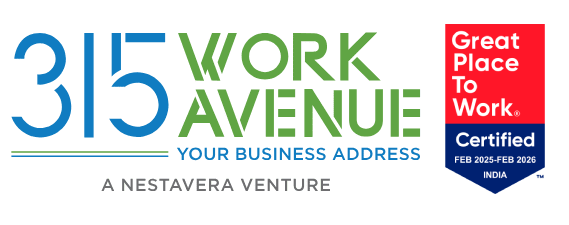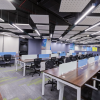The Indian workplace is transforming at a rapid pace, from the slow, plodding process of transition from offices to coworking sites to a revolution led by technology, flexibility and sustainability. Entering 2025, the future of workspaces in India is taking shape, framed around newer and growing needs for agility, well-being, and intelligence in design.
Table of Contents
1. Rise of Flexible and Managed Office Spaces
2.Sustainability in the Spotlight
3. Technology-Driven Workspaces
4. Human-Centric Design and Employee Well-being
5. The Hybrid Work Revolution
6. Community and Collaboration at the Core
7. Conclusion

Let’s explore the top workspace trends 2025 India that are changing how and where people work.
Rise of Flexible and Managed Office Spaces
One thing that has been crystal clear since the pandemic is this: agility is the key to survival. Long-term leases or rigid office setups no longer bind businesses. In fact, today, businesses are more open to flexible office space solutions whereby they can scale up or down depending on demand.
This has triggered a rise in managed office facilities in India, where companies can have fully equipped, ready-to-move-in offices without the hassles of operations or maintenance. These spaces combine the professionalism of a traditional office with the adaptability of coworking, making them the preferred choice for startups, SMEs and even large enterprises.
315Work Avenue, for example, has been at the forefront, providing such solutions, helping organizations design efficient, collaborative and scalable work environments that support business growth.
Sustainability in the Spotlight
That is why the demand for workspaces that are more sustainable within India is growing. In the year 2025, sustainability will not be a buzzword; it will be a standard.
From energy-efficient lighting and water conservation systems to ergonomic furniture and green interiors, co-working operators are investing heavily in eco-friendly infrastructure. The aim is to create work environments that reduce carbon footprints while enhancing employee well-being.
Besides this, workspace design now integrates green-certified buildings and recycled materials, implementing the country’s larger sustainable development commitments.
Technology-Driven Workspaces
Tech integration into the workspace is among the most defining workspace trends 2025 India is gearing up for. Smart offices fueled by IoT, AI, and automation are making more efficient and productive environments than anyone might have ever thought. Imagine a workspace that automatically lights and turns up the temperature when you walk in, a workstation that allows you to reserve a meeting room through an AI system – these are no longer unimaginable and have already materialised.
At the same time, coworking with high-speed internet and cloud-based collaboration tools ensures seamless connectivity for hybrid teams working across locations. As remote work becomes a permanent fixture, technology will continue to bridge the gap between flexibility and performance.
Human-Centric Design and Employee Well-being
The future of workspaces in India is not just about square feet but people. Employees today seek more than a desk; they want spaces that evoke creativity, collaboration, and comfort.
Workspace design in 2025 will be driven by biophilia, wellness zones, and breakout areas that allow people to relax and interact with each other on an informal basis. It’s natural lighting, plants, and art that would help reduce stress and perk up morale in most natural ways.
Leading coworking brands such as 315Work Avenue are creating work environments that make employees engaged and valued, more importantly, turning the workspaces into communities rather than merely offices.
The Hybrid Work Revolution
Hybrid work is not a fad, but a given basis for doing business. In 2025, companies will increasingly adopt models that blend the flexibility of remote work with the power of in-person collaboration.
This has made the trend of flexible workspaces more relevant than ever. Coworking and managed offices, for instance, are favored by businesses for allowing teams to have access to professional spaces when required, but not necessarily committing to long-term real estate costs.
The coworking space has now become a hub for collaboration, where employees gather to brainstorm, network, and innovate, yet still work independently from afar.
Community and Collaboration at the Core
Gone are the days when the best coworking spaces in India are just shared offices- they are unified as an ecosystem, complete with a network of workspaces that enable coworkers to easily transfer between hubs and share resources and ideas.
By working together with entrepreneurs and corporates, coworking spaces provide a warmer and more knowledge-sharing environment to those working at the space. Furthermore, networking and partnership opportunities are not all that rare and events, workshops and other events help you maintain your bearings. That has been a consistent theme with 315Work Avenue, our approach to making safe working spaces that foster professional and individual contemplation has always been well received.

Conclusion
India’s workspaces of the future will be: dynamic, human-centered, tech-enabled. In 2025, as employers redefine their future workforce and workplace strategies, they will rely more on flexible, sustainable and managed workspace options that also evolve as businesses and employee needs change. The place is the same, faster internet, flexibility to work, and eco-friendly.
At 315Work Avenue, we believe the office of the future is more than where people work; it’s where people connect, collaborate, and make meaningful impact.




